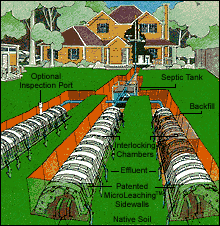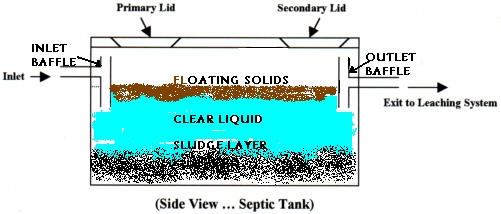GENERAL SEPTIC INFORMATION
The most popular method of sewage disposal for dwellings in suburban or rural areas where no city sewage facilities exist is the septic tank with its underground leaching system. The owner of a home with a septic tank system should learn about the design and operation of the system.
A well designed, properly constructed, and adequately maintained septic tank system can serve a home as satisfactorily as a city sewer. On the other hand, a system which does not receive the care and attention it deserves can become a burdensome expense to a home owner. It is well to remember, too, that a septic tank system that does not function properly can become a neighborhood health menace.
Therefore, home owners and new buyers should know whether the septic tank is properly designed and large enough to serve the number of occupants of the home.

- Septic Tank Flow Diagram
Homeowners should know if the tank is located where it would pose a danger to the water supply, and whether the leaching system, dry wells, infiltrators or pipe trench fields are capable of disposing of the liquid effluent at all times and under year-round weather conditions.
The purpose of a septic tank is to receive household wastes (soapy water from the laundry and the bath, discarded food scraps, body wastes, etc.). The majority of the solids rise to the top of the tank and the liquid passes into the leaching system; where it seeps out and is absorbed into the soil. Bacteria in the soil then remove some of the impurities from the liquid wastes.
When septic tank systems are improperly designed or maintained, overflows of liquid wastes from the tank or field create offensive odors, they are also a health menace. They are excellent breeding places for certain species of mosquito and other disease carrying insects. They are particularly a threat, therefore, to children and pets playing on the property.
SEPTIC TANK PUMPING
Violette Silvester’s recommends to pump your septic tank every two years!
Proper maintenance procedure calls for the septic tank to be pumped and visually inspected. The frequency with which it must be cleaned, however, depends on the size of the tank, the daily flow of sewage into it from the home, and the number of people it serves. Where a household garbage disposal is used, more frequent cleaning will be required. With ordinary use and care, the tank may need cleaning every 2 to 3 years. The home owner can ascertain for himself those periods when the tank needs cleaning. When the total depth of scum and solids (see sketch) exceeds 1/4 the liquid depth of the tank, the solids should be removed.

- How Septic Tanks Work
Note! There are no chemicals or digesting yeast’s which are capable of reducing the solids in a septic tank to the point where cleaning is unnecessary. They can be removed properly only by pumping out the septic tank.
To facilitate cleaning and maintenance operations, the home owner should provide himself with a diagram of the septic tank system. It should show the location of the house, the septic tank and manholes or access covers, the piping, and the leaching system. This information should remain on the premises, regardless of a change in occupancy.
LEACH FIELDS
Septic tanks and leaching systems can be damaged when heavy trucks or equipment are moved over the area under which they are located. A diagram of the system therefore, will enable the home owner to guide vehicles away from the critical area.
The roots of trees and shrubbery are a common source of trouble. They may enter the tile lines and clog them so completely at times that the liquid wastes are forced to the ground surface. When this occurs, the roots can be removed only by digging up and replacing the lines with new PVC pipe or by replacing the leach field in a new location.
Leaching systems suffer the most frequently, however, from neglect of cleaning the septic tank. When the tank is neglected, solids fill it up and flow into the leaching system where they stop the flow of liquid wastes. The system then must be uncovered and relocated. This is a costly undertaking and emphasizes the need for periodic inspection and cleaning of the septic tank. The tank should be inspected annually and cleaned as often as necessary. The precautions will save needless expense and trouble.
This information has been prepared for the individual home owner, as a guide to the care and maintenance of individual sewage disposal systems. For more detailed information call Violette Silvester & Sons, Inc.serving this community for over 100 years.
Remember, commercial septic tank additives do not eliminate the need for periodic pumping and may be harmful to the absorption field. Be sure when the septic tank is pumped that it is completely emptied. It is not necessary to retain any of the solids to restart the digestive process. You do not need biological or chemical additives for successful restart or continuous operation of your septic system, nor should you wash or disinfect the tank after having it pumped.
State of Connecticut, Department of Health Septic Tank Cleanout Risers Mandate
Clickhereto view our septic tank gallery.
